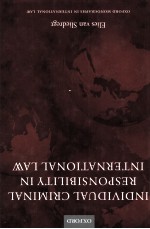

INDIVIDUAL CRIMINAL RESPONSIBILIY IN INTENATIONAL LAWPDF电子书下载
- 电子书积分:12 积分如何计算积分?
- 作 者:ELIES VAN SLIEDREGT
- 出 版 社:OREGON
- 出版年份:2012
- ISBN:0199560366
- 页数:337 页
PART 1: INTRODUCTION 3
1. Criminal Responsibility in International Law 3
1.1 War and law 3
1.2 From war crimes law to international criminal law 4
1.3 State responsibility vis-a-vis individual responsibility 5
1.4 International criminal law 8
1.4.1 Nature of norms 8
1.4.2 Pluralism or uniformity? 9
1.4.3 Sources of law 12
2. Collective Criminality, Individual Responsibility 17
2.1 Individual criminal responsibility 17
2.1.1 Developments in municipal criminal law 17
2.1.2 International criminal responsibility 18
2.2 System criminality 20
2.3 Bernays' collective criminality theory 22
2.3.1 Conspiracy-criminal responsibility at leadership level 23
2.3.2 Criminal organizations-criminal responsibility at execution level 26
2.4 Subsequent proceedings 30
2.4.1 Membership liability 32
2.4.2 Common design 33
2.4.3 Complicity 35
2.5 Concluding observations 36
3. Parameters of Criminal Responsibility 39
3.1 Terminology 39
3.2 Subjective element 40
3.2.1 ICC Statute 45
3.2.2 Ad hoc tribunals 50
3.3 Objective element 52
3.3.1 Broad and narrow understanding 53
3.3.2 Commission and omission 54
PART 2: ATTRIBUTING CRIMINAL RESPONSIBILITY 61
4. Perpetration and Participation 61
4.1 Codifying individual criminal responsibility 61
4.2 Participation in crime: a comparative perspective 65
4.2.1 Unitary and differentiated models 65
4.2.2 Derivative and autonomous models 67
4.2.3 Contribution and crime-oriented models 70
4.2.4 Naturalistic and normative models 71
4.2.5 Differentiated and unitary: a fading distinction 73
4.3 International models of participation: preliminary observations 74
4.4 Concluding remarks 74
5. Principals and Accessories 77
5.1 Introduction 77
5.2 The principal-accessory distinction 77
5.2.1 The advance of the normative approach 77
5.2.2 Bolstering the principal status 80
5.3 Distinguishing criteria: Roxin's theory 81
5.4 'Control of the crime' 83
5.4.1 Dualism 85
5.4.2 Roxin's theory and the ICC 86
5.5 Concluding observations 88
6. Forms of Criminal Responsibility 89
6.1 Introduction 89
6.2 Direct and indirect perpetration 89
6.2.1 Comparative perspective 89
6.2.2 International criminal tribunals 91
6.2.3 ICC 93
6.3 Co-perpetration 95
6.3.1 Comparative perspective 95
6.3.2 International criminal tribunals 96
6.3.3 ICC 99
6.4 Instigation, ordering, soliciting, and inducing 102
6.4.1 Comparative perspective 102
6.4.2 International criminal tribunals 104
6.4.3 ICC 107
6.5 Planning 110
6.5.1 Comparative perspective 110
6.5.2 International criminal tribunals 110
6.6 Aiding and abetting 112
6.6.1 Common law origin 112
6.6.2 Comparative perspective 116
6.6.3 International criminal tribunals 120
6.6.4 ICC 127
6.7 Common purpose liability 131
6.7.1 Comparative perspective 131
6.7.2 International criminal tribunals 133
6.7.3 ICC 145
6.8 Attempt 147
6.8.1 Comparative perspective 147
6.8.2 International criminal tribunals 150
6.8.3 ICC 151
6.9 Conclusion: mixed models of criminal participation 153
7. Crime-Specific and Leadership Modalities 157
7.1 Introduction Leadership modalities 157
7.2 JCE at leadership level 157
7.2.1 Indirect co-perpetration and interlinked JCE 158
7.2.2 Observations 163
7.3 Indirect co-perpetration at the ICC 165
7.3.1 Observations 168
7.4 Indirect co-perpetration and interlinked JCE compared Crime-specific modalities 170
7.5 Complicity in genocide 171
7.5.1 International criminal tribunals 172
7.5.2 ICC 178
7.6 Inchoate offences 179
7.6.1 Conspiracy to commit genocide 179
7.6.2 Incitement to commit genocide 180
7.7 Concluding observations: theories of imputation 181
8. Superior Responsibility 183
8.1 Introduction 183
8.2 Developments in the law on superior responsibility 184
8.2.1 The Celebici case 185
8.2.2 Successor superior responsibility 187
8.2.3 Loosening the superior-subordinate relationship 189
8.2.4 Observations 192
8.3 The ambiguous nature of superior responsibility 195
8.4 Article 28 of the ICC Statute 197
8.4.1 Textual analysis 197
8.4.2 Nature of liability 199
8.5 Superior responsibility in national law 202
8.6 A multilayered concept 204
8.7 Superior responsibility as parallel liability 206
8.7.1 Revisiting its nature 206
8.7.2 Superior responsibility as 'lex specialis 207
8.8 Concluding observations 209
PART 3: DEFENCES 213
9. Grounds for Excluding Criminal Responsibility 213
9.1 Introduction 213
9.2 Preliminary observations 214
9.2.1 International law defences and criminal law defences 215
9.2.2 Justification and excuse 215
9.2.3 The mental element and defences 217
9.2.4 The reasonable person standard and Garantenstellung 219
9.2.5 The culpa in causa or 'conduct-in-causing' analysis 221
9.3 Article 31 of the ICC Statute 221
9.4 Mental defect 224
9.4.1 Text 224
9.4.2 Comparative perspective 224
9.4.3 International jurisprudence 226
9.5 Intoxication 228
9.5.1 Text 228
9.5.2 Comparative perspective 230
9.5.3 International jurisprudence 233
9.6 Self-defence 233
9.6.1 Preliminary observations 233
9.6.2 Text 235
9.6.3 Comparative perspective 239
9.6.4 International jurisprudence 240
9.7 Duress 242
9.7.1 Text 242
9.7.2 Comparative perspective 243
9.7.3 International jurisprudence 249
9.8 Non-statutory defences 260
9.8.1 Belligerent reprisals 261
9.8.2 Tu quoque 263
9.8.3 Military necessity 264
9.9 Concluding observations 267
10. Mistake of Fact and Law 269
10.1 Introduction 269
10.2 The defence of mistake 269
10.2.1 Descriptive and normative elements 269
10.2.2 Mistake of fact 271
10.2.3 Mistake of law 271
10.2.4 The scope of mistake of law in ICL 272
10.3 International jurisprudence 274
10.4 Comparative perspective 276
10.4.1 Anglo-American law 276
10.4.2 Civil law 278
10.5 Article 32 of the ICC Statute 281
10.5.1 The interplay between Articles 32 and 30 of the ICC Statute 281
10.5.2 Interpreting Article 32 284
10.6 Concluding observations 285
11. Superior Orders 287
11.1 Introduction 287
11.2 Legal history 287
11.3 Article 33 of the ICC Statute 293
11.3.1 Text 293
11.3.2 Three conditions 295
11.4 International jurisprudence 296
11.5 Superior orders in national law 299
11.5.1 The conditional liability approach 299
11.5.2 Absolute liability approach 301
11.5.3 A combined approach 302
11.5.4 Justification or excuse? 303
11.6 Battlefield reality 304
11.7 Concluding observations 306
Annex: Selected Provisions 307
Bibliography 313
Index 333
- 《最后之战》(荷)达安·赫马·范·福斯(Daan Heerma Van Voss)著 2019
- 《将模糊理论说清楚:透析无所不在的“虚假的明确”》(英) 纪斯·迪姆特 (Deemter Kees Van)著;李隆生,张逸安译 2012
- 《裂缝性油藏工程基础 上》T.D.VAN GOLF-RACHT著;沈志成,仲雍,张纪易,刘敬奎译;仲雍校 1985
- 《从读心到攻心:七天教你掌握身体语言力》珍妮·柴佛(JANINE DRIVER),玛瑞斯卡·凡阿尔斯特(MARISKA VAN AALST)著;程珮然译 2011
- 《基础材料科学与工程 下》LAWRENCE H.VAN VLACK原著 1992
- 《西洋史大纲 张闻天手稿》(美)房龙(Van Loon)著;张闻天译 2003
- 《欧元与国际货币竞争》(荷)汉克·V.盖默特(Henk Van Gemert)等著 1999
- 《古典热力学基本原理》(美)范怀伦(Van Wylen,Gordon J.),(美)桑塔格(Sonntag,Richard E.)原著;陈响亮译著 1994
- 《经济长波与创新》(荷)杜 因(Duijn,J.J.Van)著;刘守英,罗 靖译 1993
- 《思想解放史话》H·W·Van,Loon 1936
